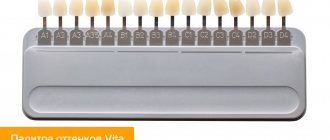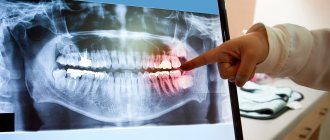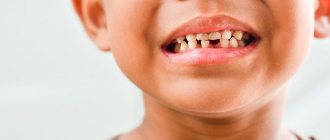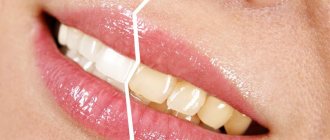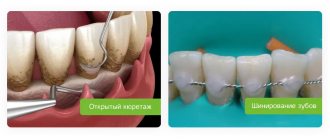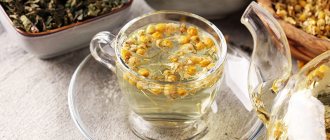In our culture, the standard of beauty is a snow-white smile. In fact, healthy, strong teeth are yellowish. The minerals contained in hard tissues give them not only strength, but also a yellowish tint. If pigmentation gets out of control, instead of a healthy shade of enamel, we end up with completely unattractive yellow teeth. This is not only an aesthetic problem, but also a psychological one. A person with yellow spots on his teeth is embarrassed to smile, prefers not to engage in conversations, and becomes withdrawn. Dentists pay a lot of attention to the problem, developing more and more new methods for lightening enamel.
Charge for regular drinks
It would seem that there is nothing reprehensible in a cup of coffee or tea in the morning, afternoon and evening. Most people have long been accustomed to these liquids, although they appeared in our culture, frankly speaking, relatively recently. One way or another, getting too carried away with them can also lead to yellow teeth. By the way, the type and color of tea does not really matter here. For example, the majority today do not even know how to choose the right green tea, opting for advertised, unnatural varieties with an abundance of artificial coloring substances. Suffice it to say that the popular so-called “milk oolong” is a chemical that the Chinese themselves will never drink.
Why do teeth turn yellow?
It all starts with a small raid. After eating or drinking, a thin film – pellicle – settles on the enamel. Bacteria begin to multiply on its surface, forming plaque. No brush can remove it completely. A dental plaque is formed, which tends to become stained under the influence of pigments, drugs, and resins.
Alas, plaque is not the only cause of yellowness, there are others:
- Genetics
Each person has their own shade of enamel. It is laid down at conception and a special gene is responsible for this. There are congenital diseases that are accompanied by enamel defects (amologenesis, marble disease). Dark shade can be inherited from nature, just like eye color or nose shape.
- Food
Through pores in the enamel, pigments from food penetrate into the dentin, changing its color. In the first place is coffee, black tea, dark berries, red wine. However, there are products whose ability to stain dentin we do not even suspect. Green tea, for example, or vegetables containing carotene: carrots, tomatoes, spinach. Water can have a yellow tint if it contains too much fluoride.
- Medicines and filling materials
Some antibiotics, the most famous of which is tetracycline, can change the color of teeth.
It also changes when using filling material, amalgam.
. Pigments from it can spread throughout the entire crown.
- Age
From the moment the first one erupts, we put our teeth to the test. We eat hot and cold, sour, drink sweet soda, crack seeds, smoke. It's no surprise that the older we get, the more likely we are to develop yellow stains on our teeth. In addition, the thickness of plaque increases over the years, changing the color of the enamel. Teeth become yellower.
- Smoking
Cigarettes contain tar and tar. They settle on the enamel, giving it a yellow-brown tint that begins to accumulate between the teeth and then spreads to the entire surface.
- Oral hygiene
If you do not take care of your teeth, forgetting about regular brushing or flossing, their color will quickly cease to please you. It is worth remembering that professional cleaning is the best way to remove plaque. It should be carried out at least once a year.
It is necessary to care not only for permanent teeth, but also for milk teeth. This needs to be done especially carefully if you have braces installed.
- Location
It happens that fangs look yellower than other teeth. This is the norm. The thickness of the enamel is the same everywhere, but the thickness of the dentin on the fangs is much greater. Therefore, the shade of the fangs is yellowish, even if the rest of the teeth are white.
- Lesions of hard tissues
With a wedge-shaped defect, the teeth turn yellow near the gums, exposing the neck. With fluorosis, yellow spots are located over the entire surface. If a yellow tint appears and it darkens over time, this is a reason to consult a doctor.
What to do with yellow teeth
Thus, we counted plenty of factors. The question remains - what to do about it? Today, technology makes it possible to solve the problem of yellow teeth quickly, painlessly and effectively. At Dentik we use the innovative ZOOM Advanced Power whitening system. It allows, using calcium phosphate and exposure to a safe diode lamp, to lighten teeth by several tones, without harming their health and guaranteeing a long-term effect. The specialist will also advise you on how to properly care for your whitened teeth and give you a set of home care products.
Contact our clinic and take advantage of this great opportunity! A dazzling smile is simple and safe!
Clinical researches
Multiple clinical studies have proven the effectiveness of Asept products. For example, as part of the tests, it was found that the two-component mouth rinse ASEPTA ACTIVE more effectively combats the causes of inflammation and bleeding compared to single-component rinses - it reduces inflammation by 41% and reduces bleeding gums by 43%.
Clinical studies have also proven that regular use of professional toothpaste ASEPTA REMINERALIZATION improved the condition of the enamel by 64% and reduced tooth sensitivity by 66% after just 4 weeks.
Clinical studies have proven that regular use of preventive toothpaste ASEPTA SENSITIVE for a month can reduce bleeding gums by 62%, reduce the sensitivity of teeth and gums by 48% and reduce inflammation by 66%.
Sources:
- Report on determining/confirming the preventive properties of toothpaste “ASEPTA PLUS” GENTLE WHITENING” Author: doctor-researcher A.A. Leontyev, head Department of Preventive Dentistry, Doctor of Medical Sciences, Professor S.B. Ulitovsky First St. Petersburg State Medical University named after. acad. I.P. Pavlova, Department of Preventive Dentistry
- Clinical and laboratory assessment of the influence of domestic therapeutic and prophylactic toothpaste based on plant extracts on the condition of the oral cavity in patients with simple marginal gingivitis. Doctor of Medical Sciences, Professor Elovikova T.M.1, Candidate of Chemical Sciences, Associate Professor Ermishina E.Yu. 2, Doctor of Technical Sciences Associate Professor Belokonova N.A. 2 Department of Therapeutic Dentistry USMU1, Department of General Chemistry USMU2
- Report on the determination/confirmation of the preventive properties of personal oral hygiene products “ASEPTA PLUS” Remineralization doctor-researcher A.A. Leontyev, head Department of Preventive Dentistry, Doctor of Medical Sciences, Professor S.B. Ulitovsky First St. Petersburg State Medical University named after. acad. I.P. Pavlova, Department of Preventive Dentistry
- Clinical studies of antisensitive toothpaste “Asepta Sensitive” (A.A. Leontyev, O.V. Kalinina, S.B. Ulitovsky) A.A. LEONTIEV, dentist O.V. KALININA, dentist S.B. ULITOVSKY, Doctor of Medical Sciences, Prof. Department of Therapeutic Dentistry, St. Petersburg State Medical University named after. acad. I.P. Pavlova
- The role of anti-inflammatory rinse in the treatment of periodontal diseases (L.Yu. Orekhova, A.A. Leontyev, S.B. Ulitovsky) L.Yu. OREKHOVA, Doctor of Medical Sciences, Prof., Head of Department; A.A. LEONTIEV, dentist; S.B. ULITOVSKY, Doctor of Medical Sciences, Prof. Department of Therapeutic Dentistry of St. Petersburg State Medical University named after. acad. I. P. Pavlova
- Report on determining/confirming the preventive properties of toothpaste “ASEPTA PLUS” COFFEE and TOBACCO Author: doctor-researcher A.A. Leontyev, head Department of Preventive Dentistry, Doctor of Medical Sciences, Professor S.B. Ulitovsky. First St. Petersburg State Medical University named after. acad. I.P. Pavlova, Department of Preventive Dentistry
- Report on determining/confirming the preventive properties of commercially produced personal oral hygiene products: Asepta toothpaste used in combination with Asepta mouthwash and Asepta gum balm Head. Department of PFS Doctor of Medical Sciences Professor S.B. Ulitovsky St. Petersburg State Medical University named after Academician I.P. Pavlova. Faculty of Dentistry. Department of Preventive Dentistry.
Special diet
It is believed that apples and raw carrots are the best teeth cleaners. These products perfectly remove plaque and supply a huge amount of useful substances to the body. Therefore, you should not limit yourself to them.
The LeaderStom network of clinics offers the services of the best pediatric dentists in Moscow. If you seek professional help in time, the condition of your child’s teeth can be correctly corrected with a course of treatment or preventive measures. Experienced therapists and orthopedists will help eliminate pathological yellowness of teeth and straighten your baby’s bite if indicated. Contact us, we are always ready to help.
Is yellowness normal or pathological?
Not every yellowness should be perceived as a deviation from the norm. Sometimes, due to hereditary factors, a child’s enamel becomes more transparent than that of other children. The lack of white pigment causes the dentin to show through, resulting in darker teeth.
Some dentists are inclined to believe that it is better not to correct or whiten such enamel. At least until the child reaches adulthood and hard tissues are fully formed.
If yellow teeth are showing signs of health, the best thing you can do for your baby is to practice good oral hygiene and good nutrition.
What causes enamel color change
There are many factors due to which teeth gradually lose their natural whiteness. Enamel is very sensitive to the effects of dyes, so frequent consumption of products such as black tea, natural berry juices or beets leads to its darkening. In addition, the outer surface of the teeth is not spared and our harmful addictions, for example, to smoking or drinking wine.
Of course, the main reason for darkening of the enamel is insufficient hygiene. In addition, plaque can accumulate due to wearing orthodontic structures - braces, as they make cleaning with a brush difficult. It is also important to know about the dangers of some tetracycline antibacterial drugs.
Another provoking factor is the progression of various diseases of the digestive tract. In any case, if you notice severe deposits on the surface of the enamel, it is recommended to go to the dental clinic for a consultation as soon as possible. An experienced doctor will help you choose the right treatment and prevent the development of complications.
How to prevent yellowing of teeth: preventive measures
To avoid the question of how to get rid of yellow plaque, it is better to prevent the problem. As already mentioned, you should give up smoking, carbonated drinks, and coffee. Drinks containing coloring pigments are best consumed through a straw. It is important to neutralize the effect of acids on enamel. To do this, after eating acid-containing foods, you need to rinse your mouth with clean water or drink it or milk. You should also avoid snacking between main meals. This promotes more effective leaching of acids with saliva.
Regular teeth cleaning is one of the main conditions for maintaining a beautiful smile. It is necessary to use dental floss and mouthwash. If you experience dry mouth, you should consult your doctor. Fluoride-containing drugs are taken under strict control.
Effective dental methods for teeth whitening
If you are really interested in how to whiten your teeth, it is better to go to a doctor and take into account his recommendations. Today dentistry offers different methods to solve the problem:
- Mechanical cleaning is the simplest method, carried out using special attachments. As a result of the procedure, soft and hard dental deposits are eliminated. This technique helps prevent caries and gum disease.
- Hardware cleaning. How to clean your teeth and eliminate their yellowness? During the procedure, the doctor removes plaque using an ultrasound machine. Special attachments allow you to remove supragingival and subgingival deposits. After the procedure, the natural shade of the teeth returns.
- Bleaching. There are different ways to lighten tooth enamel. This can be chemical, intracanal, laser and photobleaching. These techniques differ in cost and effectiveness.
- Veneers. If you are looking for a way to remove dental defects, you should consider the option of special onlays for the front teeth. Veneers allow you to get a perfectly even and, what is important in case of yellow discoloration, a snow-white smile. This technique does not involve a strong impact on tooth enamel - grinding, laser treatment, etc.
Modern techniques make it possible to lighten enamel with varying degrees of yellowness. The procedures do not cause pain in the patient and are performed quickly enough. The doctor will recommend the most suitable technique for you.
Is it possible to whiten teeth at home?
Many people often put off visiting the dentist and try to figure out how to remove yellow discoloration on their own. Often advertised and popular whitening pastes come into view today. But it is worth understanding one important point - they contain particles that act on the tooth surface like sandpaper. Mention this. Over time, such pastes damage the enamel, just like those containing activated carbon. Whitening strips sold in pharmacies also have an aggressive composition and do not have the expected effect.
You should not use baking soda and citric acid for whitening purposes - they simply corrode the enamel. What to do to avoid harming your teeth? The best thing to do at home is to practice regular and careful oral hygiene. It is also necessary to exclude from the diet or limit the amount of “bad” foods and drinks consumed and, of course, quit smoking.
Why is plaque on teeth dangerous?
Don't underestimate the plaque that accumulates on the surface of our teeth every day. It is not as harmless as it might seem at first glance. Over time, plaque can cause the development of serious pathologies, such as periodontitis. This disease affects the condition of the gum tissue and can appear against the background of already progressing gingivitis. If left untreated, the disease can lead to the loss of one or more teeth.
The plaque quickly turns into hard deposits - stone. These deposits contain small particles of food, bacteria, and calcium compounds of epithelial cells. This is no longer just an aesthetic defect, but a serious problem leading to active damage to the enamel by caries.
This pathological process is characterized by targeted demineralization of the hard tissues of the tooth, as a result of which they gradually darken and die. In this case, a cavity appears in the dentin structure, which grows over time and can even affect the root of the tooth. This pathology is difficult to treat, patients often experience relapses, and in 40% of people the situation becomes chronic.

